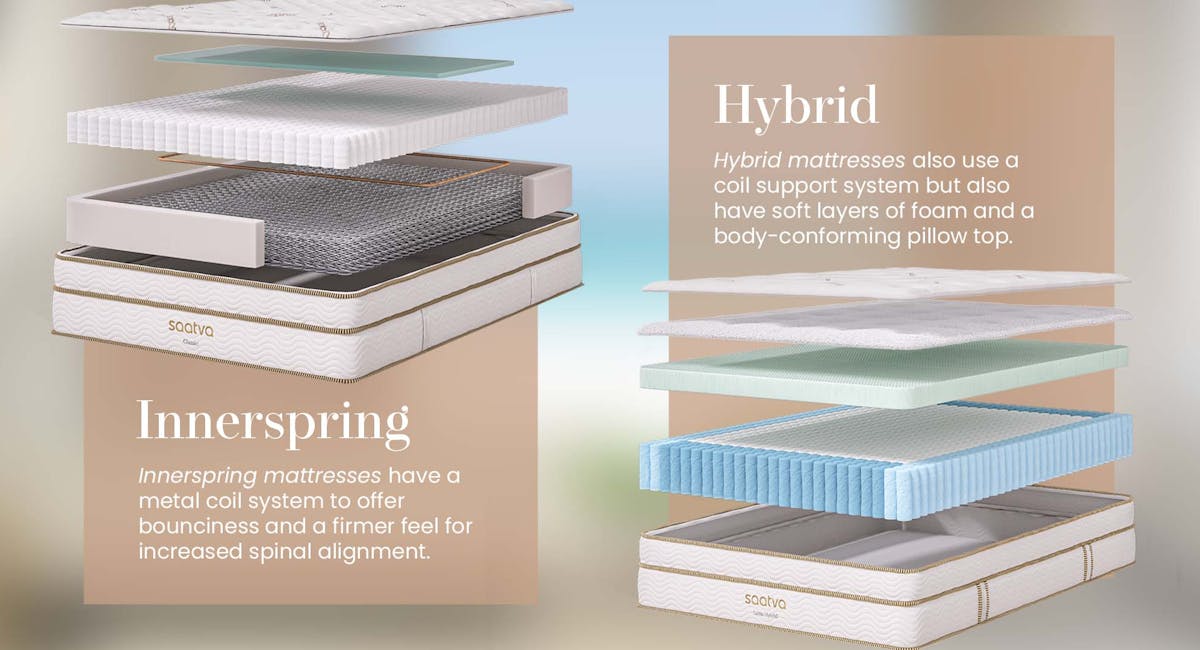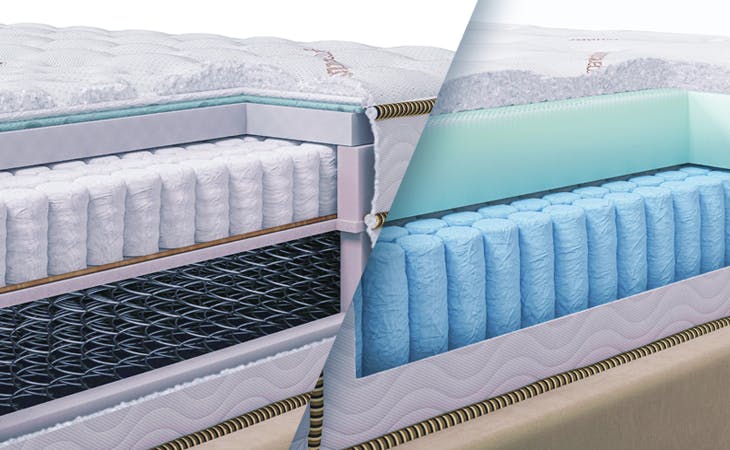Choosing the right mattress can be a daunting task. You’re not just picking a bed; you’re investing in your sleep quality and overall well-being.
With so many options out there, how do you decide what’s best for you? Two popular choices—innerspring and hybrid mattresses—often stand out. But which one truly meets your needs? In this post, we’ll dive into the key differences between innerspring and hybrid mattresses, helping you make an informed decision.
Imagine waking up refreshed every morning, free of aches and pains. The perfect mattress can transform your sleep experience and improve your life. Read on to discover which mattress type can offer you the comfort and support you crave.

Credit: www.saatva.com
Innerspring Mattress Features
Innerspring mattresses have stood the test of time. They are known for their support and durability. Many prefer them for their traditional feel. Let’s explore the key features that make innerspring mattresses unique.
Coil Construction
Coil construction is crucial for innerspring mattresses. These mattresses use metal coils for support. The coils can differ in shape and design. Some have hourglass-shaped coils, while others use pocketed coils. Pocketed coils minimize motion transfer. They provide a more isolated sleep experience. Coil count affects firmness and durability. More coils generally mean better support. Always consider the coil type when choosing a mattress.
Firmness Levels
Innerspring mattresses offer various firmness levels. Firmness depends on coil type and thickness. Thicker coils often mean firmer mattresses. Softer mattresses use thinner coils and additional cushioning. Firmness is a matter of personal preference. It’s important to test different levels. Finding the right firmness ensures better sleep quality.
Breathability And Cooling
Breathability is a key feature of innerspring mattresses. The coil structure allows air circulation. This helps keep the mattress cool. Cooling is crucial for hot sleepers. Innerspring mattresses are cooler than foam options. This feature makes them suitable for warm climates. Breathability enhances comfort during sleep.
Hybrid Mattress Characteristics
Hybrid mattresses combine the best of two worlds. They offer a blend of innerspring coils and foam layers. This combination provides comfort and support. Understanding their characteristics can help you choose wisely.
Material Composition
Hybrid mattresses use both coils and foam. Coils give support. Foam layers add comfort. Often, the foam is memory foam or latex. This mix ensures durability and a balanced feel.
Comfort Layers
Comfort layers in hybrids are thicker than in innersprings. These layers cushion pressure points. They help in reducing aches. Many hybrids have multiple foam layers. Each layer serves a specific purpose. The top layer is often soft for a cozy feel.
Temperature Regulation
Hybrids excel in temperature control. The coil system allows airflow. This keeps the mattress cool. Many also have gel-infused foam. This draws heat away from the body. Sleep comfortably without overheating.
Durability And Longevity
Choosing between innerspring and hybrid mattresses often hinges on durability and longevity. These factors determine how well a mattress holds up over time. A durable mattress saves money and ensures a good night’s sleep.
Wear And Tear
Innerspring mattresses often show signs of wear faster. The coils may sag or lose their bounce. Over time, this affects comfort and support. Hybrid mattresses combine coils and foam layers. This design usually offers better durability. The foam helps maintain shape and support. Yet, both types can experience wear if not cared for properly.
Maintenance Tips
Regularly rotating your mattress can extend its life. This prevents sagging and uneven wear. Use a mattress protector to guard against spills and stains. For innerspring mattresses, avoid jumping or placing heavy objects on them. This protects the coils from damage. For hybrids, ensure proper support from a sturdy bed frame. Cleaning your mattress regularly keeps it fresh and increases longevity. Follow manufacturer care instructions for best results.
Support And Comfort Comparison
Choosing between innerspring and hybrid mattresses can be tricky. Both offer unique support and comfort features. Understanding these differences helps in making informed decisions. Let’s delve into how each type performs in terms of pressure relief and body contouring.
Pressure Relief
Innerspring mattresses use coils to provide support. They can be firm and bouncy. This might lead to pressure points. Especially for side sleepers. Hybrid mattresses combine foam and coils. The foam layers help in distributing weight evenly. This reduces pressure on shoulders and hips. A better choice for pressure relief.
Body Contouring
Innerspring mattresses often lack body contouring. The springs offer limited adaptability to body shape. This can result in less comfort for some. Hybrid mattresses excel in body contouring. The foam layers adapt to curves. Providing a snug and personalized fit. Enhances comfort by hugging the body. Ideal for those seeking tailored support.
Cost Considerations
When deciding between innerspring and hybrid mattresses, cost plays a key role. Understanding the price range and value for money helps make an informed choice. Let’s explore these considerations to find the best option for your budget.
Price Range
Innerspring mattresses often have a lower starting price. They can fit smaller budgets. Prices range from $200 to $1,000, depending on brand and quality. Hybrid mattresses usually cost more. Their price ranges from $500 to $2,000. This range reflects their advanced construction.
Value For Money
Innerspring models offer good value with basic support features. They serve well for guest rooms or short-term use. Hybrids provide a blend of comfort and durability. They justify higher prices with enhanced comfort layers. Invest in a hybrid for long-term sleep quality. Consider lifespan and user satisfaction when evaluating value.

Credit: www.saatva.com
Consumer Preferences
When choosing between an innerspring and a hybrid mattress, consumer preferences play a crucial role. Understanding what you value most in a mattress can help you make the best decision for your sleep quality and overall comfort. Let’s dive into some key factors, like sleep positions and lifestyle, that often influence these preferences.
Sleep Positions
Your sleep position can greatly affect your mattress choice. If you prefer sleeping on your back, an innerspring mattress might provide the firm support you need. The coils offer a stable surface, which can help keep your spine aligned.
For side sleepers, a hybrid mattress could be more appealing. It combines the support of coils with the comfort of foam, which can cushion your shoulders and hips. This mix often leads to a more restful night for side sleepers.
Stomach sleepers, have you considered how your mattress affects you? A firmer innerspring might prevent your hips from sinking too much, keeping your spine in a neutral position. Everyone’s body is unique, so it’s worth testing different options to see what feels right.
Lifestyle Factors
Your lifestyle can also shape your mattress preference. Do you often find yourself overheating during the night? Innerspring mattresses typically provide better airflow, helping you stay cool.
If you share your bed with a partner or a pet, a hybrid might offer better motion isolation. The foam layers can absorb movements, minimizing disturbances and promoting undisturbed sleep.
Consider how often you move or travel. If you need a mattress that’s easy to transport or set up, hybrids often come compressed and in a box for convenience. Think about what fits your lifestyle best and prioritize those features.
Each choice has unique benefits, but only you know what aligns with your needs. What matters most to you—support, comfort, or convenience? Understanding your preferences will guide you to the mattress that enhances your sleep and supports your daily life.
Pros And Cons
Choosing the right mattress can be tricky. Innerspring and hybrid mattresses offer unique benefits and challenges. Understanding their pros and cons helps make an informed decision.
Advantages Of Innerspring
Innerspring mattresses offer great support. They use metal coils for stability and bounce. Many sleepers find this comfortable. These mattresses are often affordable and widely available. Their firm structure suits back and stomach sleepers well. They also provide good airflow, keeping you cool at night. Maintenance is easy, with fewer issues like sagging.
Drawbacks Of Hybrid
Hybrids blend foam and coils, offering mixed benefits. This mix can sometimes lead to uneven wear. Some users experience sagging with time. They are often more expensive than innerspring options. Foam layers may trap heat, making sleep uncomfortable. The weight of hybrids can make them hard to move. They might not suit sleepers who prefer firm surfaces.

Credit: www.turmerry.com
Frequently Asked Questions
What Are Innerspring Mattresses Made Of?
Innerspring mattresses primarily consist of steel coils for support. They are topped with layers of padding for comfort. The coil system can vary in design, affecting the mattress’s firmness and durability. The materials used in the padding can also differ, impacting the overall feel and breathability.
How Do Hybrid Mattresses Differ From Innerspring?
Hybrid mattresses combine innerspring coils with foam layers, offering a blend of support and comfort. They usually include memory foam or latex, which enhances pressure relief. This combination allows hybrids to provide better motion isolation and contouring compared to traditional innerspring models.
Which Mattress Type Offers Better Durability?
Hybrid mattresses generally offer better durability due to their construction. The combination of coils and high-quality foam layers enhances longevity. However, the durability of both types depends on the materials used and the quality of construction. Proper care can also extend the lifespan of any mattress.
Are Innerspring Mattresses Good For Back Pain?
Innerspring mattresses can be good for back pain if they provide adequate support. The coil system helps maintain spinal alignment, which is crucial for relieving pain. However, the level of comfort and support varies by model. It’s essential to choose one that matches your firmness preference.
Conclusion
Choosing between innerspring and hybrid mattresses depends on personal needs. Innerspring offers firm support and durability. Ideal for those who prefer a traditional feel. Hybrid combines foam and coils. Provides a balance of comfort and support. Great for those wanting the best of both worlds.
Consider sleep position, comfort preference, and budget. These factors help in making the best choice. Both mattress types have their strengths. Evaluate them carefully. A good night’s sleep awaits. Rest easy knowing you made an informed decision.
